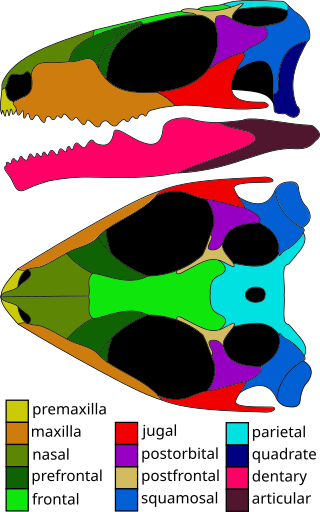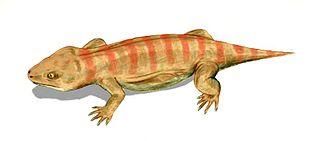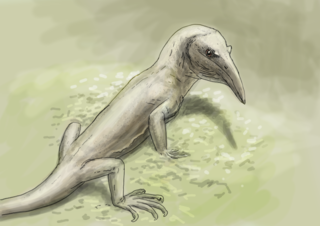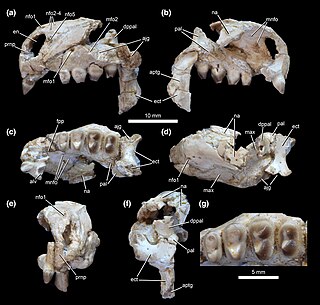
Azendohsaurus is an extinct genus of herbivorous archosauromorph reptile from roughly the late Middle to early Late Triassic Period of Morocco and Madagascar. The type species, Azendohsaurus laaroussii, was described and named by Jean-Michel Dutuit in 1972 based on partial jaw fragments and some teeth from Morocco. A second species from Madagascar, A. madagaskarensis, was first described in 2010 by John J. Flynn and colleagues from a multitude of specimens representing almost the entire skeleton. The generic name "Azendoh lizard" is for the village of Azendoh, a local village near where it was first discovered in the Atlas Mountains. It was a bulky quadruped that unlike other early archosauromorphs had a relatively short tail and robust limbs that were held in an odd mix of sprawled hind limbs and raised forelimbs. It had a long neck and a proportionately small head with remarkably sauropod-like jaws and teeth.

Trilophosaurs are lizard-like Triassic allokotosaur reptiles related to the archosaurs. The best known genus is Trilophosaurus, a herbivore up to 2.5 metres long. It had a short, unusually heavily built skull, equipped with massive, broad flattened cheek teeth with sharp shearing surfaces for cutting up tough plant material. Teeth are absent from the premaxilla and front of the lower jaw, which in life were probably equipped with a horny beak.
Spinosuchus is an extinct genus of trilophosaurid allokotosaur from the Late Triassic of Texas, southern United States. It has been assigned to a variety of groups over its history, from coelophysid dinosaur to pseudosuchian to uncertain theropod dinosaur and to Proterosuchidae. This uncertainty is not unusual, given that it was only known from a poorly preserved, wall-mounted, partial vertebral column of an animal that lived in a time of diverse, poorly known reptile groups. However, newly collected material and recent phylogenetic studies of early archosauromorphs suggest that it represents an advanced trilophosaurid very closely related to Trilophosaurus.

Hypsognathus is an extinct genus of procolophonid parareptile from the Late Triassic of New Jersey, Connecticut, and Nova Scotia.

Claudiosaurus is an extinct genus of diapsid reptiles from the Late Permian Sakamena Formation of the Morondava Basin, Madagascar. It has been suggested to be semi-aquatic.

Planocephalosaurus is an extinct genus of basal rhynchocephalian. Fossils of the genus are primarily known from fissure fill deposits from the Late Triassic of southwest Britain, with fragmentary remains possibly belonging to the genus also known from the Late Triassic of Texas.

Procolophon is a genus of lizard-like procolophonid parareptiles that first appeared in the Early Triassic (Induan) of South Africa, Brazil, and Antarctica. It persisted through the Permian–Triassic extinction event, but went extinct in the beginning of the Early Middle Triassic. The type species is P. trigoniceps.

Trilophosaurus is a lizard-like trilophosaurid allokotosaur known from the Late Triassic of North America. It was a herbivore up to 2.5 m long. It had a short, unusually heavily built skull, equipped with massive, broad flattened cheek teeth with sharp shearing surfaces for cutting up tough plant material. Teeth are absent from the premaxilla and front of the lower jaw, which in life were probably equipped with a horny beak.

Leptopleuron is an extinct genus of procolophonid that lived in the dry lands during the late Triassic in Elgin of northern Scotland and was the first to be included in the clade of Procolophonidae. First described by English paleontologist and biologist Sir Richard Owen, Leptopleuron is derived from two Greek bases, leptos for "slender" and pleuron for "rib," describing it as having slender ribs. The fossil is also known by a second name, Telerpeton, which is derived from the Greek bases tele for "far off" and herpeton for "reptile." In Scotland, Leptopleuron was found specifically in the Lossiemouth Sandstone Formation. The yellow sandstone it was located in was poorly lithified with wind coming from the southwest. The environment is also described to consist of barchan dunes due to the winds, ranging up to 20 m tall that spread during dry phases into flood plains. Procolophonoids such as Leptopleuron were considered an essential addition to the terrestrial ecosystem during the Triassic.

Clevosaurus is an extinct genus of rhynchocephalian reptile from the Late Triassic and the Early Jurassic periods. Species of Clevosaurus were widespread across Pangaea, and have been found on all continents except Australia and Antarctica. Five species of Clevosaurus have been found in ancient fissure fill deposits in south-west England and Wales, alongside other sphenodontians, early mammals and dinosaurs. In regards to its Pangaean distribution, C. hadroprodon is the oldest record of a sphenodontian from Gondwana, though its affinity to Clevosaurus has been questioned.

The Magnesian Conglomerate is a geological formation in Clifton, Bristol in England, Gloucestershire and southern Wales, present in Tytherington, Durdham Down, Slickstones Quarry and Cromhall Quarry.
Euscolosuchus is an extinct genus of suchian archosaurs from the Late Triassic of Virginia. It is probably an aetosauriform, as the sister taxon to Acaenasuchus and a relative of aetosaurs.

Diphydontosaurus is an extinct genus of small rhynchocephalian reptile from the Late Triassic of Europe. It is the most primitive known member of Sphenodontia.
Uatchitodon is an extinct genus of Late Triassic reptile known only from isolated teeth. Based on the structure of the teeth, Uatchitodon was probably a carnivorous archosauromorph. Folded grooves on the teeth indicate that the animal was likely venomous, with the grooves being channels for salivary venom. The teeth are similar to those of living venomous squamates such as Heloderma and venomous snakes. Uatchitodon is the earliest known venomous reptile.
Variodens is an extinct genus of trilophosaur. Fossils have been found from the Emborough Quarries in the Mendip Hills of Somerset, England. These fossils have been uncovered from a Late Triassic fissure fill within Carboniferous-age limestone. The type and only known species is V. inopinatus, named in 1957.

Teraterpeton is an extinct genus of trilophosaurid archosauromorphs. It is known from a partial skeleton from the Late Triassic Wolfville Formation of Nova Scotia, described in 2003. It has many unique features seen in no other related form, including an elongated, toothless snout and large openings for the nostrils. Because of this, Teraterpeton was originally placed in its own family, Teraterpetidae, related to Trilophosaurus. Newer studies generally place it within Trilophosauridae.
Theledectes is an extinct genus of theledectine procolophonid parareptile from middle Triassic deposits of Free State Province, South Africa.The type species, Theledectes perforatus, is based on the holotype BP/1/4585, a flattened skull. This skull was collected by the South African palaeontologist, James W. Kitching from Hugoskop in the Rouxville District and referred to subzone B of the Cynognathus Assemblage Zone of the Burgersdorp Formation, Beaufort Group. The genus was first named by Sean P. Modesto and Ross J. Damiani in 2003. However, the species was initially assigned to the genus Thelegnathus by C.E. Gow in 1977, as the species Thelegnathus perforatus.
Palacrodon is an extinct genus of Triassic reptile with a widespread distribution. It was initially described from teeth collected in Early Triassic deposits in South Africa, and later reported from the Early Triassic of Antarctica and the Late Triassic of Arizona. Although previously considered an early rhynchocephalian, it is currently considered to be a non-saurian neodiapsid.
Coartaredens is an extinct genus of reptile from the Middle Triassic of England. It contains a single species, Coartaredens isaaci, from the Anisian-age Otter Sandstone of Devon. The species is based on a partial jaw and other fragments with large conical teeth. Though originally described as a lepidosauromorph, some authors have instead considered it to be a procolophonid.

Hwiccewyrm is an extinct genus of leptopleuronine procolophonid parareptile from the Late Triassic Magnesian Conglomerate of England. The type, and currently only, species is H. trispiculum.













